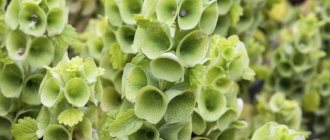Description of the gladiolus plant
The plant is a multi-varietal fennel plant. Varieties differ from each other in the shape and size of the flower, smell, flowering time and place of growth.
How does gladiolus grow?
For normal growth, it is necessary to plant bulbs of the same size, since larger plants can inhibit smaller ones. Before planting, they must be peeled and inspected. The plant will have large flowers if only one sprout is left.
Important! Do not combine large-flowered gladioli with small-flowered ones or tall varieties with short ones in landscape design. Small and low flowers will lose their attractiveness.
The rest need to be broken off. The corm is ready for planting if the sprout size is 15 cm. If necessary, they are placed in a warm, bright place for germination. The distance between the bulbs and between the rows is 15–25 cm. It is necessary to plant in a checkerboard pattern to a depth of about 15 cm.
Bouquets of flowers look good in flower beds in the garden. To do this, you should plant them in a circle with a diameter of up to 30 cm at a distance of 15–20 cm. After they bloom, you need to stick a support rod into the center of the circle and tie the entire bouquet around it.
Beautiful compositions with bouquets of growing flowers in markets. To do this, you need to choose large pots, since the length of the plant's roots reaches 30 cm. The number of planted bulbs depends on the size of the pot, approximately 6–8 pieces. In landscape design, skewer is planted together with dahlias and phlox. Then the emphasis is on the upper part, and the bareness of the lower part is hidden with low-growing flowers.
Video: Planting gladioli in a pot
Where does it grow and what does it smell like?
Geography of gladiolus growth from southern Africa to Eurasia. The homeland of this plant is considered to be southeastern Africa. In natural conditions on the Mediterranean coast, in Kazakhstan, central and eastern Europe, you can find imbricated gladiolus.
Did you know? Gladiolus can be considered a medicinal plant. The concentration of ascorbic acid in its leaves is the same as in rose hips.
Most varieties are odorless.
Acedonthera is a fragrant gladiolus with origins from Ethiopia. It has a very aromatic and pleasant smell that can be felt from a distance. Their scent can be compared to jasmine, hyacinth or violet. If you plant it in a sunny area, the smell will be stronger than in the shade.
It has flowers about 10 cm in diameter and are white, yellow, pink or light purple. There are not as many of them on the stem as a regular gladiolus. The approximate quantity is up to 5 pieces and they bloom gradually. Therefore, it is necessary to plant it in group bouquets. Then it looks very expressive in the flowerbed and gives a bright spot of color. It is necessary to plant and care for acedonthera in the same way as for ordinary gladioli.
For a long time, breeders have been struggling to develop varieties not only with improved external characteristics, but also with greater aroma power. This is how Gladanthera was bred. It is a hybrid between gladiolus and acedonthera and therefore perfectly combines the characteristics of both.
Landscape design
Any landscape design will benefit if gladioli are one of the compositions. Even the smallest garden plot can be perfectly decorated if there are gladioli. Planting bulbs in the spring will turn it into a flower fairy tale by the end of summer.
Flowers are given a place near houses, along fences and paths. Gladioli, planted near a small country pond, will look charming. They decorate lawns, flower beds, and flower beds with swords. It is planted in a single composition, or whole ensembles of several varieties are made up.
Gladiolus looks ideal in a group planting with dahlias, marigolds, silver wormwood, phlox, and ageratum.
Previously we told: Soapwort.
Having thought through the color scheme and the timing of plant flowering, you can create amazing floral masterpieces that will bring joy to many people.
Types of gladiolus
The fennel genus includes 280 species. The main ones:
- Gladiolus baumii (lat.) was described by the German botanist Hermann Harms (1870–1942) in 1903. It is distinguished by numerous sinewy leaves, a one-sided spike-shaped inflorescence and a pinkish perianth.
- Gladiolus commúnis (lat.) - common sword. It is distinguished by leaves with smooth edges, placed in two rows on the stem. The flowers are purple-red, with white stripes in the middle.
- Gladiolus imbricátus (lat.) - imbricated skewer. It has a double corm, broad-linear leaves, and a one-sided, spike-shaped, dense inflorescence of pink-violet color.
- Gladiolus murielae (lat.) - Muriel's sword or bicolor acidanthera. Characterized by two long sword-shaped leaf blades, individual flowers with pointed petals of white color with a dark purple center. Has a pleasant smell.
- Gladiolus palūstris (lat.) - marsh sword. It is distinguished by an ovoid tuber and a spike-shaped inflorescence of bright pink color. It grows in marshy areas of central and southern Europe. In the Russian Federation it is listed in the Red Book.
- Gladiolus tenuis (lat.) - thin sword. It has a pair of scale-like leaves and greatly reduced scale-like bracts, one-sided spike-shaped inflorescences with closely spaced flowers and pink perianths. The species is listed in the Red Books of Ukraine and the Russian Federation.
After crossing different species, breeders created many hybrids. Each variety of garden swords belongs to a hybrid species and is subject to registration. It has been held since 1945 by the North American Gladiolus Council. Each new variety is assigned a digital code.
It characterizes the flower (its size and color). In first place is size on a six-point scale, in second place is color (from 0 to 9). Information about color intensity and additional colorings is encoded by the third digit. Next, the flowering period, two digits of the year in which this variety was grown and the name of the breeder are indicated through hyphens.
Find out also about the use of gladioli in folk medicine.
On average, the variety lives about 10 years. With repeated reproduction, defects appear in the characteristics and this affects its life expectancy. Every day new varieties appear with more unusual colors, corrugation and other characteristics.
Video: Digital code of gladioli
American culture classification
Americans also liked the flower with sword-shaped leaves. It was in the USA that a classification of plants according to the shape and shade of the flower was developed. Each color and configuration of the petals was assigned a code, each number of which indicates the color of the petals, the size of the flower, the presence of other tones in the color and many other parameters. By deciphering this code, you can get a general idea of the variety.
For example, the variety Shokoladnitsa 592-S-81 Evdokimov means that the size of the flower is gigantic (5), the color range is smoky brown (9), and the color is monochromatic (2). The letter C indicates that the flowering period is average. 81 is the year the variety was bred (1981), and Evdokimov is the surname of the creator. Now it’s easy to imagine how beautiful this variety is, with large flowers of a creamy chocolate color.
Careful planting and care of the plant
Even a novice gardener will be able to plant and care for these flowers. To grow beautiful plants with long peduncles, follow these simple recommendations:
- Plant the bulbs in early May in a sunny location. To the bed where you are going to plant gladioli, add a complex of fertilizers: 1 tbsp per 1 m². a spoonful of urea and double superphosphate, as well as a handful of wood ash.
- The skewer likes regular, abundant watering without stagnant water in the garden and loosening the soil. Beds with flowers must be constantly weeded so as not to introduce fungal diseases with weeds.
- The first feeding can be done when 2-3 leaves appear. Use 2 tbsp. spoons of urea per 10 liters of water. To get large corms, it is necessary to fertilize with boric acid during this period (2 g of boric acid per 10 liters of water).
- The second feeding is carried out when the peduncle begins to grow. For this, 1.5 tbsp. spoons of nitrophoska are dissolved in 10 liters of water.
- The third feeding after flowering is carried out to prepare the bulbs for storage. 1 tbsp. spoon of crushed superphosphate, 2 tbsp. spoons of potassium sulfate and 5 g of potassium permanganate per 10 liters of water.
- Digging of bulbs is carried out at the end of September in dry weather. Lay them out in a dry place in one layer. After drying, cut off the stems with a sharp knife, leaving a stump of 2–4 cm.
- In order for the bulbs to be stored well, they must be completely dried for a month at room temperature. The old onion and roots are removed and stored in a fabric bag in the refrigerator or cellar.
general information
Gladiolus is a capricious perennial that requires a lot of attention at any time. The height of the powerful straight stem reaches 1.5 m, and it is surrounded by hard thin leaves about half the height. The rest is occupied by a powerful inflorescence, on which large buds are densely collected.
The root system of gladioli consists of corms on which thin small roots grow. These bulbs are covered with dense scales, from under which sprouts hatch. In fact, each bulb is renewed annually.
The timing of flowering depends entirely on the specific species and variety. Some bloom at the very beginning of summer, while others bloom closer to autumn. Funnel-shaped flowers are collected in arrow-shaped inflorescences and gradually open from bottom to top.
Photo: fr.wallpaper.mob.org
How are gladioli propagated?
Plants reproduce with the help of tubers - small children growing around the main bulb. They are dug up and stored along with large bulbs. In the spring, they are planted for germination in the garden bed to a depth of 5 cm in small ditches. In a year they will definitely bloom.
Important! Plants grown in the garden from tuber buds are more adapted to growth in these conditions and are more resistant to diseases.
Planting material constantly needs to be updated, so in order to preserve the plant, you should not ignore planting children. There is no need to peel the husks from the children before planting. It is enough to press with your fingers until a slight click occurs, that is, to break the integrity of the husk for easier germination of the sprout.
Possible problems in growing
Despite the unpretentiousness of the species, it is often attacked by all kinds of pests. Due to improper care, gladiolus can get sick.
- Pests. The main parasites that harm the plant are thrips, mites, and garden ants. Less commonly, the common aphid. Timely treatment of the flower with insecticidal agents will not only protect the damaged plant from pests, but will also serve as a prophylactic agent.
- Diseases. Most often, flowers are susceptible to fungal diseases. For prevention, it is necessary to treat not only the plant, but also the planting material. Phytosporin is considered the best remedy for these purposes. Treatment with this drug can be carried out throughout the season.
- Signs of improper care. The most important sign that proves that the plant has not received due attention is the absence of flowers on the gladiolus. This trouble can arise due to untimely watering or poor quality care.
Gladiolus is a generally recognized royal species. Not everyone is able to grow this elegant work of art from a small bulb. The flower requires constant care and close attention. If a gardener is not confident in his abilities, then it is better to first try to grow something simpler and not so capricious. But, despite all the difficulties, the risk justifies the result.
Diseases, pests and how to deal with them
Bacterial, fungal and viral diseases along with pests threaten the growth of beautiful swords. Plants can get sick:
- Fusarium - a disease caused by fungi of the fusarium species. Another name is dry rot. It causes root rot and plant wilting.
- Gray or solid rot - fungal disease. It is characterized by yellowing of the tips of the leaves and the appearance of various spots on them.
- Scabby - bacterial disease. Can be recognized by red-brown spots on the lower part of the plant.
- Mosaic - viral disease. Leaves and flowers become striped and rough, uncharacteristic of the species.
- Jaundice - viral disease. The leaves turn yellow and the flowers turn greenish.
- Cancer - bacterial disease. Characteristics of which are growths on tubers.
Fusarium, rot and scab are easier to prevent than to fight them. This must be done by inspecting the tubers during planting and the plants during the growth period. If the leaves turn yellow or spots appear on them, then it is necessary to determine the disease by comparing it with photos of the affected plants.
In case of viral diseases, tubers and plants must be removed and burned. Crop rotation helps in the fight against diseases and pests. To do this, plant the tubers in different places every year. Copper sulfate, potassium permanganate, etc. are used to disinfect the planting site.
Important! Areas overgrown with wheatgrass have a beneficial effect on the reproduction of wireworms, so it is necessary to fight it first. Reducing the acidity of the soil with lime, chalk, ash or dolomite flour will also help.
The most common pests that attack a plant are:
- Thrips - insects 1.5 mm in size and dark brown in color. They have light wings on their back, so they spread easily. Thrips suck the juice from the leaves and they dry out. White streaks and black dots are clearly visible on the leaf blades. The buds of affected plants do not bloom. In their middle you can see yellow-brown larvae. Insects can also infect the bulb during storage by getting into the basement along with the harvest. When pests first appear, plants are treated with insecticides. The treatment is repeated after 10–14 days until complete destruction. Infusions of garlic and tobacco also help repel pests. If the thrips are not destroyed by the time the bulbs are dug, they need to be treated by soaking them in an insecticide solution for 15 minutes. Afterwards dry well.
- Wireworms - These are the larvae of click beetles. They can make passages in the bulbs through which fungi and bacteria enter, causing rot. The pest can be controlled using insecticides or folk remedies.
- Medvedki - large insects living in the ground, dark brown in color. Insecticides are used to control the pest. They are laid out in holes when planting according to the instructions.
Pests can be controlled by heat treatment of gladiolus tubers. Before planting, soak them for 10 minutes. into water with a temperature of +50°C. In order not to cook the seed, it is necessary to strictly adhere to the temperature regime.
Choosing a location on the site
Bright blooming gladioli. Photo from pixabay.com
Gladioli are plants that require bright light to grow healthy, so it is best to choose an unshaded location with good sunlight.
It is preferable that the selected area is not blown from all sides - the tall thorns of gladioli do not like the wind.
There are certain requirements for the soil. Gladioli prefer light soils: black soil with a low content of clay and sand. The problem of high clay content in the soil is solved by adding sand to it.
Monitor the groundwater level in the area chosen for planting: if it is too high, then it is better to find another place for gladioli.
It is important!
Gladioli cannot be planted in the same place for 2 years in a row, so take this into account when choosing a planting location.
Legend of the flower
Since the flower has been grown since ancient times, people have created legends and myths about it. According to one of them, gladioli grew from the swords of brave warriors.
Did you know? Gladioli bulbs have been used as food since before our era. First they were baked and mashed together with onions. Then cakes were made from this mass.
The Romans fought with the Thracians. Victory in the war went to the Romans. The Roman commander ordered the captured soldiers to be made gladiators. Sevt and Teres became great friends. Longing for homeland and freedom united them. Slavish humiliation in captivity, on the one hand, oppressed them, but on the other hand, it made them even more friendly.
The cruel commander wanted to see a fight between friends. The reward for the winner was a return to their homeland. When the trumpets began to play and the crowd was ready to see the fight, the friends stuck their swords into the ground and hugged each other. "Why don't they fight?" - shouted the angry spectators. The young men decided that it was better to die than to entertain the bloodthirsty public. They were executed, and in place of the swords beautiful flowers grew, which were named gladioli in their honor. To this day, they symbolize friendship, loyalty, nobility and the memory of brave warriors.
The ancient plant gladiolus is shrouded in history and legends. It is a wonderful decoration for any flower bed. Due to its unpretentiousness and simple care, it is grown by almost every gardener. You just need to know some of the subtleties of this process and the bouquets in your flower beds will delight you with large, healthy flowers of all kinds of colors.
Varietal preferences
There are about two hundred species in total (they grow wild in Africa and Central Asia). The variety determines the color of the flowers. It is varied: from rich, red (“Life Flame”, “Jungle Flower”) to exotic dark purple (Fairy of the Night, Prince of Indigo), light golden, green (Green Pasches). Gardeners love snow-white flowers (“Madonna”, “Swan”, “Apollo”).
- Flowering months are from late July to September (depending on the variety).
- The months for planting vary by region. The flower is heat-loving; it is planted in the ground after the threat of frost has passed and the ground has warmed up to +10 degrees. Landmark: planting onions.
- The beneficial properties remain in the shadow of the external beauty of the flower. Its leaves are rich in vitamin C, and a decoction of them strengthens the immune system. A crushed onion applied to a wound can speed up healing. It is believed that gladiolus tincture has an antispasmodic effect.
It is known from history that Roman gladiators wore a flower bulb around their necks as a talisman. In Africa, gladiolus is considered a flower of happiness; in Japan it symbolizes care and constancy. Many gardeners are of the opinion that the skewer protects the area from troubles. And yet, first of all, gladioli are loved for their long flowering and proud, regal appearance. Getting beautiful flowers requires a lot of effort from the gardener. It is important to properly prepare the bulbs and choose the location of the flower garden.











